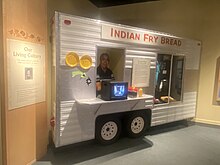Frybread
According to Navajo tradition, frybread was created in 1864 using the flour, sugar, salt and lard that was given to them by the United States government when the Navajo, who were living in Arizona, were forced to make the 300-mile journey known as the "Long Walk" and relocate to Bosque Redondo, New Mexico, onto land that could not easily support their traditional staples of vegetables and beans.
[1] To prevent the displaced Native Americans from starving, the United States government provided a small set of staple food items, which included the ingredients with which to create a simple quick bread which was cooked in a pan of hot lard over coals and became known as frybread.
[4] That same year, activist Suzan Shown Harjo wrote a piece against frybread in Indian Country Today, calling the dish "emblematic of the long trails from home and freedom to confinement and rations...It's the connecting dot between healthy children and obesity, hypertension, diabetes, dialysis, blindness, amputations, and slow death"; critics have accused Harjo of overstating her case and unfairly blaming frybread for problems facing Native Americans.
Indigenous chef Sean Sherman calls it "everything that isn't Native American food",[7] writing that it represents "perseverance and pain, ingenuity and resilience".
[9] However, indigenous chefs such as Sherman consider it a symbol of colonial oppression,[9] as the ingredients were being provided because the government had moved the people onto land that could not support growing traditional staples like corn and beans.
A typical frybread recipe consists of flour, water, salt, a small amount of oil or lard, and sometimes baking powder or more rarely yeast.




